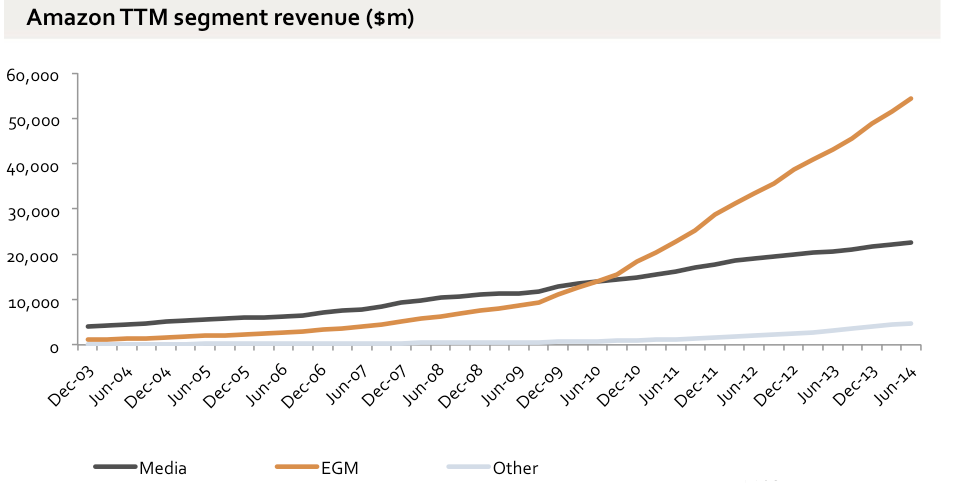Introduction
Based on the case study, Amazon has attractive financial standing and stable capital structure due to series strategic financing strategies from the year 1995. This paper will explore the milestones that the company may explore to attract outsider funding, growth stages, financing stages, valuation, and performance after the 1998 IPO.
Venture Milestones
Amazon.com would have established a number of milestones within itself to evaluate the attractiveness of the venture in attracting external funding. For instance, being a company with global brand image, the company integrates strategic financial management through balancing equity and different financial ratios. For instance, balancing the short terms and long terms financial needs as a management strategy would guarantee a clear framework for negotiating external funding. Through enhancing venture management, the company will be in a position to promote sustainable revenue generation and profitability in the foreseeable future.
The second milestone is integrating the capital structure to boost its capital strength to pursue the set business objectives. Amazon.com would reflect on the capital enhancement that can be adduced by the venture arrangement in ensuring that business plan and related objectives such as product development are effectively implemented. This milestone in necessary in penetrating the internet retail market effectively since predictable capital structure is equivalent to sustainable company equity performance.
As a result, Prospective investors will find it viable to invest in the business venture and provide the required external funding due to the high profitability prospects by reviewing the current performance trends. Investment expansion is another milestone that Amazon.com should have established. Pursuing the path of investment expansion is instrumental in attracting external financing for the intended venture arrangement due to the role it plays in enhancing the wealth of the investors. Investment expansion would guarantee higher earnings per share and dividends to potential investors.
Development Stages of the Company
Amazon.com has undergone different development stages from its initiation stage to the current stage. The first stage that the business has undergone is the existence stage, which involves attracting customers and delivering the products as promised to the customers (Churchill & Lewis, 2010). Amazon.com started at its initial by sourcing for the consumers to target and delivering the products efficiently and effectively to earn their loyalty (Brigham & Houston, 2009). The second stage that Amazon.com has undergone is the survival stage. The survival stage is where a business faces problems in balancing its expenses and revenues (Churchill & Lewis, 2010).
This stage lasted for almost six year from the year 1995 since the financial capacity and equity was not adequate to support rapid expansion. During its survival stage, Amazon.com experienced challenges with the management of its expenses to generate profit from the revenue it collected (Brigham & Houston, 2009). The third stage the Amazon.com has undergone is the success stage, which involves assessing whether the business should exploit its accomplishments by expanding or keeping the business profitable and stable as an alternative base for a new business. The equity grew tenfold as the expansionary policies begun to pay off (Churchill & Lewis, 2010).
During its success stage, Amazon.com’s has focused on marshalling its resources to boost the expansion and profitability of its operations. The last development stage the Amazon.com Corporation has undergone is the resource maturity stage (Brigham & Houston, 2009). The resource maturity stage involves the business entity consolidating and controlling its financial gains, which have been brought about the rapid growth in revenues and profitability (Churchill & Lewis, 2010). Amazon.com is facing this stage after the initial public offer in 1997 that has seen the prices of the stock more than double.
Financing Stages
Amazon.com has undergone diverse financing stages in marshalling resources to support its operations. The first stage that Amazon.com has undergone is the personal financing, which involves the owner contributing his own funds to start off the business operations of the new venture (Leach & Melicher, 2015). Amazon.com’s founder, Bezos initiated the Amazon.com enterprise from his personal finances consisting of $10,000.
The second stage of financing that the business has undergone is that of venture financing. The venture financing avenues exploited by Amazon.com involved soliciting for finances from interested investors with the guarantee of surrendering a certain percentage of the company’s ownership to them. The firm has also benefited from debt financing, where Bezos borrowed funds from different banks under his own guarantee to finance the operations of the business. Between 1995 and 1997, Amazon borrowed more than $100,000 from different financial institutions to finance its rapid expansion (Brigham & Houston, 2009).
Furthermore, the business has undergone the equity financing stage through the floating of its preferred and common stocks during its initial public offer of 1997 which raised more than $326,000,000 to support further expansion and repay the previous loans. Amazon’s financing stages correspond to the development stages undergone by the business since they are informed by the resource requirement at each stage. Similarly, the financing stages correspond to the milestones identified because the financing needs at each stage are aimed at realizing the various milestones as summarized in appendix 1.
Company Valuation
The valuation of Amazon.com since its initiation has changed significantly over time. The valuation of the firm has relatively increased from $10,000 in 1995 to more than $300, 000,000 by the end of the year 1998. Amazon.com has experienced an increasing trend in its valuation as demonstrated by the increasing per value of its shares from $18 before the IPO to $124 after the 1998 IPO. Between the year 1997 and 1998, the company’s stock price increased 28 times the sales revenues during the period. The various financing approaches undertaken by Amazon.com through its venture financing and private debt carry special terms.
The special terms attached to the two types of financing play an essential role of ensuring that the available funds are applied for the intended purposes without diversion or pilferage. For instance, Amazon was able to negotiate for 0% interest rates during the venture financing stage. During the debt financing stage, the company was able to negotiate for loans for shares and relatively lower interest rates. Similarly, the financing terms play an essential role in ensuring the financiers have the right to monitor the conduct and the performance of the business.
1997 IPO
The decision by Amazon.com to undertake an initial public offer in 1997 to raise equity capital could have been motivated by the higher price that the diversified external investors are willing to pay compared to the conservative price offered by the constricted internal investors of the company (Simon & Helmantelc, 2009). The external investors have diversified views regarding the ability of a company to generate cash flows in the future compared to the internal investors due to the information asymmetry that exists between the two types of investors (Damodaran, 2011).
The average market sentiment towards the future profitability of the new mode of internet retailing introduced by the Amazon.com could have favoured higher price offerings from the external investors who would be willing to pay more for the shareholding in the enterprise compared to the internal investors. The management of Amazion.com undertook the decision to float its shares in the IPO to maximize the firm’s capital base. The external investors were also highly receptive to the IPO offering by the Amazon.com due to the expected higher earnings in the future under the investment (Intintoli, Jategaonkar, & Kahle, 2014).
As a result, the IPO generated $326,000,000 in the form of new funds for expansion and offsetting previous debts. The prospects that the investors have, on the new retail approach to generate huge higher revenues at low cost, motivated the external investors to consider buying the Amazon.com’s stock to earn higher dividends and capital gains in the future (Abdullah & Ismail, 2008). In fact, it paid off since the stock prices increased from $18 before the IPO to $124 after the IPO (Yahoo Finance, 2015).
Amazon.com’s Stock Price
The stock price of Amazon.com as of July 1998 after the 1997 initial public offer appears to be overpriced since the performance of the company then and future prospects were not clear (Damodaran, 2011). The rapid growth of the Amazon.com stock price at the beginning of June1998 could have been attributed to high public expectation on the profitability of the company (Brigham & Houston, 2009). The demand of the stock remained high during the period, which influenced the stock price to increase steadily as indicated in appendix 2 (Damodaran, 2011).
The chart in appendix 2 demonstrates the stock price trend of Amazon Corporation in the last ten years. From the chart, it is evident that Amazon.com’s stock price has experienced a steady and exponential growth in the last ten years. The chart indicates that the firm’s stock price during the 1997 IPO and the stock price in 2012 have recorded a significant positive variation.
The huge difference between the two stock prices demonstrates that the shareholders’ sentiments shared during the IPO of 1997 regarding the potential of the stock to increase in the future were well informed (Brigham & Ehrhardt, 2010). The potential rise in capital gains was main motivation behind the highly subscribed Amazon.com’s stock during the 1997 IPO as indicated in appendix 3.
A profitability trend during the period prior to the Amazon Corporation’s IPO in 1997 has been demonstrated in appendix 3. The chart reflects that Amazon Corporation was on a loss making streak prior to the IPO. Contrary to the established norm, Amazon Corporation attracted a high number of investors during its initial public offer that saw the price of the stock to increase exponentially in the subsequent years due to the pressures induced by high demand (Siregar & Utama, 2008).
The profitability trend of Amazon.com in the four years demonstrates that the stock price employed at the initial public offer was overvalued as indicated in appendix 4. A closer analysis on the trends indicates that the revenue generation has been expanding at a significant rate during the eighteen years. In contrast, the net profit in the last ten years has remained stagnant.
The stagnating net profit trend of Amazon.com Corporation at a time when its revenues increased exponentially is an illustration of poor cost management strategies (Barnes, 2006; Gibson, 2011). A firm with a growing revenue generation is expected to experience a similar trend in profit making since high revenues should induce high profitability (Liesz & Maranville, 2008).
From the available data in appendix 4, it is highly likely that the management of the Amazon Corporation has not been prudent in managing the costs incurred in running the business to enhance the firm’s profitability in the face of growing revenues. An analysis of the revenue generation by the different segments of Amazon.com’s operations has been demonstrated by the charts below.
The chart depicts that EGM and media segments of the Amazon Corporation have been experiencing high growth in revenue generation while other segments have been experiencing stagnant revenue grow The stagnating profitability of Amazon Corporation could be attributed to the stagnant revenue growth of other segments. The company could be investing huge financial resources in the other segments to enhance their performance with little immediate returns (Wainwright, 2012).
The aggressive approach taken by the firm by divesting heavily to promote the performance of the other segments could be hurting the profitability of the corporation over the past 10 financial years. To mitigate a further decline in profitability, Amazon’s management should consider discontinuing operations in the less profitable segments to focus all resources in the productive segments as summarized in appendix 5 and appendix 6 (Anderson, Sweeney, Williams, Camm, & Martin, 2011).
The sales growth of the Amazon Corporation is another essential factor that demonstrates its future financial prospects (De Franco, Kothari, & Verdi, 2009). The graph in appendix 5 demonstrates the sales growth of Amazon Corporation from 1994 to 1998. The graph demonstrates that Amazon Corporation has experienced better sales growth trend after the IPO. The high sales growth trend of the Amazon Corporation is an indication that it has maintained a competitive edge over its rivals in the online retailing platform (Collier, 2009).
The meteoric rise of the Amazon Corporation’s stock price demonstrated earlier could be fair. The upshot of the stock price during the period despite the loss-making trend of the firm could be fair because the sales growth reflected in the graph is an indication of the firm’s future cash flow strength over its rivals in the industry (DuBrin, 2008).
The high sales growth of the Amazon Corporation in the industry implies that the shareholders of the firm should expect high free cash flow generation in the future (Ramnath, 2002). The present value of the stock, which is influenced by the expected cash flows in the future, will be high. The high sales growth rate experienced by the firm is an indication of Amazon’s penetration efficiency. The extent to which a firm is able to generate sales revenue is determined by its ability to expand its market coverage (Hansen, Mowen, & Guan, 2009).
Accordingly, the high sales growth rate of Amazon Corporation is experiencing in the industry in the industry is an illustration that the firm has the potential of experiencing high sales revenues in the future, which is vital in enhancing the net income attributable to the shareholders.
References
Abdullah, A., & Ismail, N. (2008). Disclosure of voluntary accounting ratios by Malaysian listed companies. Journal of Financial Reporting and Accounting, 6(1), 1-20.
Anderson, D., Sweeney, D., Williams, T., Camm, J., & Martin, K. (2011). An introduction to management science: Quantitative approaches to decision making. New York, NY: Cengage Learning.
Barnes, P. (2006). The analysis and use of financial ratios: A review article. Journal of Business Finance & Accounting, 4(4), 449-461.
Brigham, E. F., & Houston, J. F. (2009). Fundamentals of financial management. Mason, OH: Thomson/South-Western.
Brigham, F., & Ehrhardt, M. (2010). Financial management theory and practice. New York, NY: Cengage Learning.
Churchill, N. C., & Lewis, V. L. (2010). The Five Stages of Small Business Growth. Web.
Collier, P. (2009). Accounting for managers. New York, NY: John Wiley & Sons Ltd.
Damodaran, A. (2011). Applied corporate finance. Hoboken, NJ: John Wiley & Sons.
De Franco, G., Kothari, S., & Verdi, R. (2009). The Benefits of Financial Statement Comparability. Northwestern Education: Kellogg. Web.
DuBrin, A. (2008). Essentials of management. New York, NY: Cengage Learning.
Fabozzi, F. J. (2010). Financial Risk Management. Hoboken: John Wiley & Sons, Inc.
Gibson, C.H. (2011). Financial Reporting and Analysis. New York, NY: Cengage.
Hansen, R., Mowen, M., & Guan, L. (2009). Cost management: accounting & control. New York, NY: South Western Cengage Learning.
Intintoli, V. J., Jategaonkar, S. P., & Kahle, K. M. (2014). The Effect of Demand for Shares on the Timing and Underpricing of Seasoned Equity Offers. Financial Management , 43 (1), 61-86.
Leach, J. C., & Melicher, R. W. (2015). Entrepreneurial finance. Stamford, CT: Cengage Learning.
Liesz, T., & Maranville, S. (2008). Ratio analysis featuring the DuPont method: An overlook topic in the finance module of small business management and entrepreneurship courses. Small Business Institute Journal, 2(1) 17-34.
Ramnath, S. (2002). Investor and analyst reactions to earnings announcements of related firms: An empirical analysis. Journal of Accounting Research, 40(5), 1351-1376.
Simon, B., & Helmantelc, M. (2009). The timing of initial public offerings. Journal of Financial Economics, 75(4), 115–132.
Siregar, S. V., & Utama, S. (2008). Types of earnings management and the effect of ownership structure firm size, and corporate-governance practices: Evidence from Indonesia. The International Journal of Accounting, 43(1), 1-27.
Stice, J. D., Stice., & Earl, K. (2013). Intermediate accounting. Mason, OH: South-Western Cengage Learning.
Wainwright, S. (2012). Principles of accounting. San Diego, CA: Bridgepoint Education, Inc.
Yahoo Finance. (2015). Amazon.com Inc. Web.
Appendices
Appendix 1: Financing stages
(Churchill & Lewis, 2010)
Appendix 2: Rapid growth in share prices
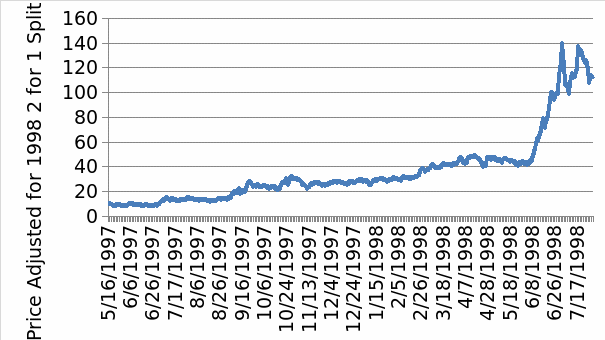
Appendix 3: Stock price performance
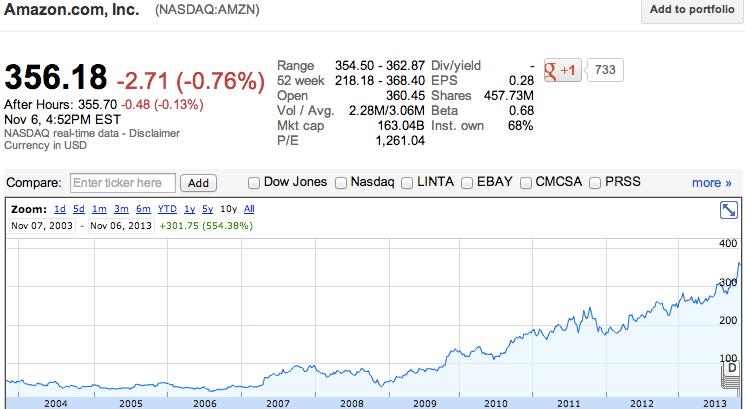
Appendix 4: Overpriced stocks of Amazon
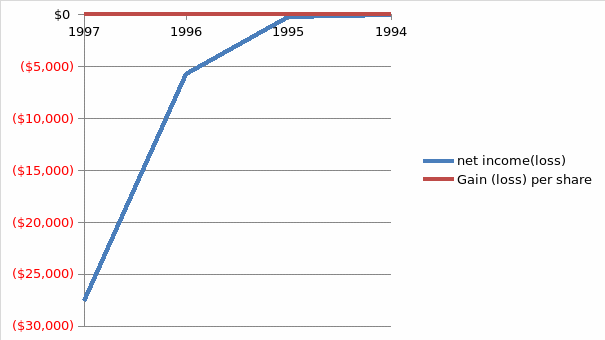
Appendix 5: revenue and net income
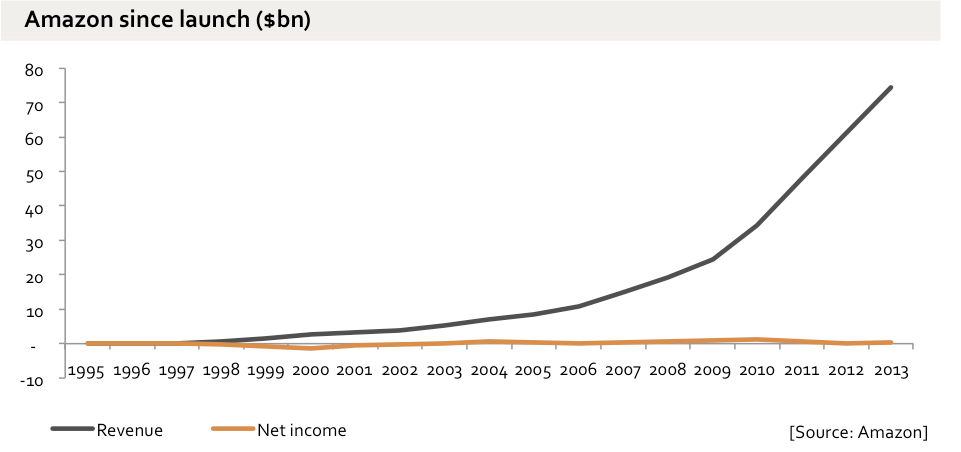
Appendix 6: segment performance
